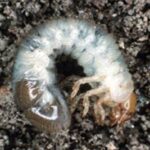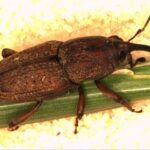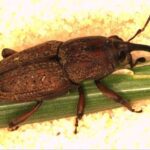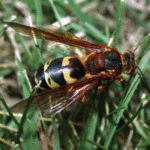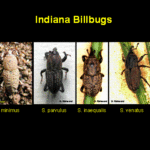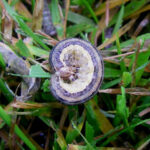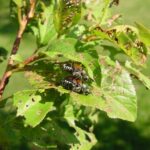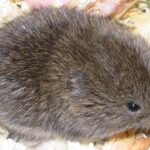Category: Pest Control
August Is Grub Target Month
This is the time of year to target for grub control. Whether your grub control products were applied a month ago, last week or are to be applied next week, the time when they actually do their work is early August. This is because grub eggs usually hatch by the end of July in the […]
Goose Round-up – ‘Yee-Haw’
The Giant Canada goose (Anatidae: Branta canadensis maxima) recently has become one of the most serious pests of parks and golf courses in the Eastern half of the United States. These geese are probably the most adaptable of all waterfowl and, if left undisturbed, will readily establish nesting territories on ponds in residential subdivisions, condominium complexes, city […]
Hunting Billbugs in Zoysiagrass
Hunting billbug is becoming a significant problem in parts of southern Indiana where zoysiagrass is grown. These insects typically have two generations per year in this part of the Midwest with the larvae of both generations being capable of causing significant injury to turf. Sporadic adult hunting billbug activity has already been observed in the […]
Tiny Trails in Turfgrass
With the winter snows melting away many are often surprised to find a series of tiny trails on the surface of their lawns and turfgrass fields. These are vole highways. Voles are often called meadow mice or field mice. While they are similar to a house mouse in general size and shape, they have some […]
Cicada killers: A Nuisance or a Danger?
A number of solitary bees and wasps reside in turfgrass and landscapes. Because of their ability to harm humans, these insects often evoke a great deal of anxiety. However, in reality they very rarely sting. Education is the single best strategy to help people deal with cicada killers. Cicada killers are one of the largest […]
White Grub Biology and Control in Espanol
In response to requests from our industry, we will be teaching a workshop in Spanish at Field Day on July 21. “White Grub Biology and Control” will be taught by Victoria Caceres from the Department of Entomology. This is a great opportunity for you or any of your staff who are comfortable learning in Spanish […]
Season-long Grub Control Advertisements
Grub control products are currently being displayed in the center aisles of retail department and discount stores and are advertised on the radio as providing season-long grub control when applied in early May. What are the facts behind this recommendation? While certain grub control products do have a very long residual in the soil, they […]
Billbugs on the move in Southern Indiana
Superintendants and lawn care professionals in the southernmost counties of Indiana should be advised that adult billbug activity has already been documented at one of the monitoring sites in the Evansville area. Mr. Jeff Sexton, Assistant Superintendant at Rolling Hills Country Club in Newburgh, Indiana captured his first billbugs adults of the year last week. […]
Billbugs a Pest in 2008? Keep Them in Mind for 2009
This summer saw some extensive billbug damage in many parts of Indiana. Obvious damage to Kentucky bluegrass in the central and northern parts of the state are not uncommon and can usually be attributed to the bluegrass billbug. However, reports of severe damage to Zoysiagrass in the Evansville area really caught my attention. Zoysiagrass is […]
Armyworms Are Poised For Battle
We have been monitoring reports of very large infestations of armyworm moths flying into Kentucky this spring. Armyworms move north with storms from the southern states each year and depending upon how and where the storms blow will dictate when and how many moths we have to deal with. Fortunately, in Indiana we have not […]
Mole Control – Buyer Beware
Moles are back at it again!. These small subterranean, tunnel-making pests can cause big frustrations for those managing turfgrass and landscapes. Mole damage is most noticeable during the spring and fall, but spring may be the most effective time to control them. Moles are gray, furry, mammals that reach 6–8 inches in length. They have […]
Three Invasive White Grubs Found By Indiana Survey
The presence of three potentially serious white grub pests of turfgrass and ornamental plants were confirmed this year during surveys conducted by the Turfgrass Entomology and Applied Ecology Laboratory at Purdue University and the Indiana Cooperative Agricultural Pest Survey with the help of several golf course superintendents, concerned citizens and one very keen graduate student […]
Grub damage reports beginning to come in
Reports of grub damage are becoming more frequent this week. A number of reports of damage have come from northern IN where moisture conditions have created ideal conditions for grub damage in spite of preventative insecticide applications. If grub damage and live grubs are confirmed, insecticide applications are likely justified to limit future animal feeding […]
Nematode Survey Still On-Going
As summer stresses start to take a toll on our cool-season grasses on greens, more questions are arising about the potential of nematodes. We found ring and stunt nematodes in many of our samples from last year, but we’re not convinced yet that they are a primary cause in turf decline (see http://www.agry.purdue.edu/turf/tips/2006/nem112.htm for complete results). Pinpointing […]
Early Japanese Beetles
It seems that the Japanese beetles have been arriving early for the last few years but this year is truly an exception. The first Japanese beetles of the year were observed in central Indiana on the 3rd of June. This is a full week earlier than we have EVER seen them here before. Normally, Japanese […]
Early billbug activity
It appears that our unseasonably warm spring has pushed the activity of many insects as much as 2-3 weeks ahead of traditional expectations. Among the turfgrass insects that are showing up early this year are the billbugs. These insects over-winter as adult weevils and become active in the spring when soil temperatures reach about 50°F, […]
We need help tracking new white grub species
The presence of two potentially serious white grub pests of turfgrass and ornamental plants has recently been confirmed in three northern Indiana counties; Porter, St. Joseph and Allen. The European chafer and Asiatic garden beetle are similar in biology to their cousins, the masked chafer and Japanese beetle, yet differ enough in behavior, habitat and […]
A New Threat to Indiana Turfgrass: Two Species of Invasive Scarab Beetles (White grubs) Found in Northern Indiana
It was just a matter of time. While invasive species such as the emerald ash borer have been garnering so much attention in the press, the Turfgrass Entomology and Applied Ecology Laboratory at Purdue University has been tracking the spread of three additional species of invasive, turfgrass infesting white grubs (European chafer, Asiatic garden beetle […]
Voles (remember the V)
During late March and April we get many calls about voles and vole damage in turfgrass. Voles are among the most important vertebrate pests in turf areas. Unfortunately the name ‘vole’ is very close to the name ‘mole’ causing some confusion and miscommunication. Even though both can damage turfgrass – the differences between voles and […]
Earthworms Activity in Lawns
Earthworm activity is on the rise as soils warm up, but their mounds will be highly visible until grass starts growing in late March and April. Earthworms are highly beneficial because they create channels for air and water penetration, reduce thatch, and tend to increase the fertility and health of a soil. However, some will […]
